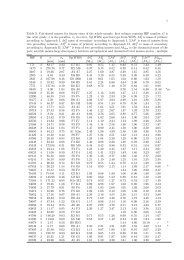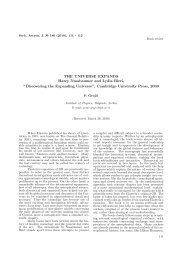V. BÖHM et al.during the two years 491 and 571 are given in Table3. First column describes the mutual positions<strong>of</strong> both planets (1st or 2nd conjunction, their oppositionwith the Sun and the Mayan dates B and Cdescribed above). The second column gives the JDand <strong>calendar</strong> date, computed with the B&B correlation.The positions (geocentric mean ecliptical <strong>long</strong>itudeλ and latitude β) <strong>of</strong> both planets in degreesare given in columns 3 and 4 calculated for the datesgiven in column 2, only for the cases <strong>of</strong> conjunctions.For the oppositions, their computed JD and <strong>calendar</strong>dates are given instead, for Jupiter and Saturn,respectively. Last column then shows the angulardistances <strong>of</strong> both planets at the moments <strong>of</strong> theirconjunctions and also for the Mayan dates given inDC. The situation <strong>of</strong> the table is graphically depictedNow it is necessary to find such shift between the<strong>dating</strong> in Julian Days and Long Count for which thedates B and C (in LC) fall into a close vicinity <strong>of</strong>computed times <strong>of</strong> conjunctions <strong>of</strong> Jupiter and Saturn(in JD). We found that this can be achieved onlywhen <strong>using</strong> the B&B correlation (τ=622 261 days),the others failed. Using this value, we arrive to dateB being equivalent to JD = 1 900 651 (i.e., September13, 491) and date C corresponding to JD = 1 929 771(June 5, 571).Both Mayan dates B, C fall into the periodwhen Jupiter and Saturn were very close to their oppositionwith the Sun (only three days apart, respectively),and they stayed close to each other for manymonths, describing wobbles with direct and reversemotions, and showing unique situation when twoconjunctions repeated during the same year. Mayandates then reflect encounters <strong>of</strong> Jupiter with Sat-in Figs. 3 and 4, for better illustration. The angularCALENDARdistance between the two planets changed duringDATING OF MAYANurn in the moments when they were close to stationarypoints (change from retrograde to direct mo-the years 491 and 571 only a little and very slowly,DATING OF MAYAN soCALENDARthat for a terrestrial observer they both stayed formany weeks in a very close vicinity, describing thetion). The mutual positions <strong>of</strong> Jupiter and Saturn apparent wobbles almost in parallel.β [deg] β [deg]0 .00 .0-0 .52 3 M a r-0 .51 J a n2 3 M a r-1 .01 J a n1 3 S ep-1 .02 5 S ep1 0 D ec1 3 S ep-1 .52 5 S ep1 0 D ecJ u p iter-1 .5S a tu rn-2 .0J u p iterS a tu rn2 9 5-2 .03 0 0 3 0 5 3 1 0 3 1 5 3 2 02 9 5 3 0 0 3 0 5 λ [deg] 3 1 0 3 1 5 3 2 0λ [deg]Fig. 3. Ecliptical <strong>long</strong>itude λ and latitude β <strong>of</strong> Jupiter and Saturn, during the year 491 AD, covering theirrepeated conjunctions.Fig. 3. Ecliptical <strong>long</strong>itude λ and latitude β <strong>of</strong> Jupiter and Saturn, during the year 491 AD, covering theirrepeated conjunctions.β [deg] β [deg]3 .023 .5 .02 .0 .55 J u n1 J a n 2 5 F eb12 .5 .05 J u n2 9 A u g1 J a n 2 5 F eb2 7 O c t1 .0 .52 9 A u g2 7 O c t01 .5 .0J u p iter0 .0 .5S a tu rnJ u p iter2 0 60 .02 0 8 2 1 0 2 1 2 2 1 4 2 1 6 2 1 8 2 2 0 2 2 2 2 2 4 2 2 6 S a tu rn2 2 82 0 6 2 0 8 2 1 0 2 1 2 2 1 4 2 1 6λ [deg] 2 1 8 2 2 0 2 2 2 2 2 4 2 2 6 2 2 8λ [deg]Fig. 4. Ecliptical <strong>long</strong>itude λ and latitude β<strong>of</strong> <strong>of</strong> Jupiter and Saturn, during the year 571 AD, covering theirrepeated conjunctions.Fig. 4. Ecliptical <strong>long</strong>itude λ and latitude β <strong>of</strong> Jupiter and Saturn, during the year 571 AD, covering theirrepeated conjunctions.583.4 S yn ch ron ization <strong>of</strong> syn od ic an d sid eric p e- minus glyph (Fig. 5). This interval is equal to multiples<strong>of</strong> synodic and sideric period <strong>of</strong> Mercury andriod s <strong>of</strong> M ercu ry w ith trop ical year3.4 S yn ch ron ization <strong>of</strong> syn od ic an d sid eric p e- tropical minus glyph year. (Fig. After5). this This interval, interval Mercury is equal rises to multiples<strong>of</strong> synodic and sideric period <strong>of</strong> Mercury andandriod s <strong>of</strong> M ercu ry w ith trop ical yearSimilarly to the preceding section, we were sets at the same place in the sky. The interval contains:tropical year. After this interval, Mercury rises andlooking in the DC for two dates differing by 2 200Similarly to the preceding section, we were sets at 19 the synodic same place periods in <strong>of</strong> the Mercury sky. The (115.877484d),interval contains:25 sideric periods <strong>of</strong> Mercurydays, the interval after which the synodic and sidericlooking in the DC for two dates differing by 2 200(87.968581d),
DATING OF MAYAN CALENDARTable 3. Mutual positions <strong>of</strong> Jupiter and Saturn close to their repeated conjunctions.Mutual position JD, Jupiter’s position Saturn’s position Angular<strong>calendar</strong> date λ β λ β distance1st conjunction 1 900 477 309.632 −0.724 309.569 −0.996 0.279March 23, 491opposition 1 900 610 1 900 607August 3, 491 July 31, 491(8.17.11.1.10) 1 900 651 307.846 −1.266 306.125 −1.371 1.72413 Oc September 13, 4912nd conjunction 1 900 663 307.352 −1.243 305.746 −1.363 1.611September 25, 4911st conjunction 1 929 671 217.046 1.318 217.532 2.500 1.280February 25, 571opposition 1 929 725 1 929 728April 20, 571 April 23, 571(9.1.11.17.10) 1 929 771 207.674 1.229 211.652 2.496 4.17213 Oc June 5, 5712nd conjunction 1 929 856 213.532 0.871 213.528 2.147 1.276August 29, 5713.4 Synchrony <strong>of</strong> synodic and sideric periods<strong>of</strong> Mercury with tropical yearSimilarly to the preceding section, we werelooking in the DC for two dates differing by 2 200days, the interval after which the synodic and sidericperiods <strong>of</strong> Mercury and tropical year are again it thesame phase. We found such occurrence on page D 24(F 24). Two introductory Mayan dates on page D 24and the form <strong>of</strong> the inscription is the following:A) 9.9.16.0.0 4 Ahau 8 Cumku 1 366 560−6.2.0 −2 200B) 9.9.9.16.0 1 Ahau 18 Kayab l 364 360The interval <strong>of</strong> 2 200 days between the two dates Aand B is expressed directly and accompanied by aminus glyph (Fig. 5). This interval is equal to multiples<strong>of</strong> synodic and sideric period <strong>of</strong> Mercury andtropical year. After this interval, Mercury rises andsets at the same place in the sky. The interval contains:19 synodic periods <strong>of</strong> Mercury (115.877484d),25 sideric periods <strong>of</strong> Mercury (87.968581d),6 tropical years (365.242199d).When <strong>using</strong> the B&B correlation, both Mayandates refer to the positions <strong>of</strong> Mercury when close tomaximum west e<strong>long</strong>ations. In addition, they assurethat the planet was close to the aphelion <strong>of</strong> its eccentricorbit, when maximum e<strong>long</strong>ation was 27 ◦ 49 ′ .The conditions to observe Mercury were thus extremelyfavorable; for a terrestrial observer, Mercurywas not only near the maximum e<strong>long</strong>ation, but alsonear its maximum distance from the Sun, so that itwas more than 19 degrees above the horizon beforesunrise (Fig. 6).9 99 916 90 160 01 366 560 days1 364 360 days62200 days 2Ahau 8 Cumku01 Ahau 18 Kayab1 Ahau18 Uo9. 9. 16. 0. 0 4 Ahau 8 Cumku 1 366 560 days- 6. 2. 0 - 2 200 days9. 9. 9. 16. 0 1 Ahau 18 Kayab 1 364 360 days(9. 14. 2. 6. 0) 1 Ahau 18 Uo 1 397640 daysFig. 5. Dresden Codex, p. D 24 (F 24), data forMercury. The newly discovered interval <strong>of</strong> 2 200 daysmeans a synchrony <strong>of</strong> synodic and sideric periods <strong>of</strong>the planet with the tropical year. The minus glyphis represented by a frame around ‘glyph zero’(see leftcolumn 6.2.0).59







